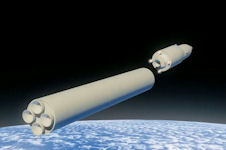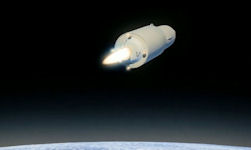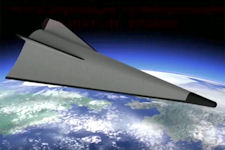Avanguard / Vanguard
Avangard is a strategic system with an intercontinental ballistic missile equipped with a planning hypersonic winged combat unit. It is able to fly in dense layers of the atmosphere at hypersonic speed, maneuvering along the course and altitude and overcoming anti-missile defense. According to open sources, the guided hypersonic combat unit (head) of the Avangard intercontinental ballistic missile complex was created as part of the experimental design work "4202" by specialists of the NPO Mashinostroyenia Military Industrial Corporation (Reutov). Initially, the carrier of the strategic hypersonic weapon will be the UR-100N UTTH rocket, subsequently - the newest heavy rocket “Sarmat”.
Pavel Podvig of russianforces wrote 20 September 2020 that "Avangard is a system from the 1980s, which was kept on life support by NPOMash own funds. Decision to proceed with it was made only after ABM Treaty withdrawal. No investment was made before that." Vanguard was put on combat duty in December 2019. The first two UR-100N UTTX intercontinental ballistic missiles, equipped with the Avangard nuclear planning block, would be on pilot combat duty in late November - early December in the Dombarovsky division of the Strategic Missile Forces. TASS reported in October 2018 that a source in the defense industry stated that two Vanguard regiments, six missiles in silos in each, should enter combat duty in the RF Armed Forces.
The first regiment of the Avangard hypersonic complexes, which took up combat duty at the end of 2019 in the Orenburg region, will be brought up to full strength (six silo launchers) at the end of 2021. A source in the military-industrial complex told TASS on 23 December 2020. "The first regiment of the Yasnensky formation of the Strategic Missile Forces (Strategic Missile Forces) will have six silo launchers by the end of next year. Thus, it will be brought up to full strength," the source said. The next two UR-100N UTTKh missiles with the Avangard hypersonic combat equipment could take up combat duty in one of the regiments of the Yasnensky Strategic Missile Forces formation on approximately 25 December 2020.
At a meeting of the expanded collegium of the military department, Russian Defense Minister Sergei Shoigu announced the continuation of rearmament of this regiment for complexes with the Avangard hypersonic gliding wing units. According to the collection "Main Results of the Activities of the RF Armed Forces in 2012-2020", prepared by the RF Ministry of Defense, which is at the disposal of TASS, by the end of December four Avangard missile systems will be on alert. According to the collection, to date, five successful launches of an intercontinental ballistic missile with these hypersonic units had been carried out.
Vladimir Putin congratulated Professor Gerbert Yefremov, prominent missile and space-rocket designer, Honorary CEO, Honorary Chief Designer, Advisor for Science at the MIC NPO Mashinostroyenia, on Gunsmith Day, 19 September 2020. Putin said " ... for decades we were always in a position of having to catch up. You are well aware of that. This concerned nuclear weapons, then long-range strategic aviation, and later also intercontinental missiles, which specialists call delivery systems. This always put our nation in a very challenging and even precarious position. In fact, there were moments when we were threatened while we had nothing to respond with. In reality, let me reiterate, it was an obvious and dangerous violation of the strategic balance.
"And now, for the first time in our contemporary history, Russia has the most cutting-edge types of weapons that are far superior to all earlier and current weapons in terms of their power, capability, speed, and, which is crucial, precision. Nobody else in the world has this type of weapons, at least at the moment.
"In this connection, on Gunsmith Day, I congratulate the designers and manufacturers of the Peresvet laser system, Kinzhal hypersonic air missile, Poseidon nuclear-powered unmanned underwater system, Burevestnik unlimited-range cruise missile, Zircon navy-based hypersonic missile, and other types of weapons that are already delivered or will be delivered shortly to our army and navy.
"But the Avangard system has a special place among them as it has a manoeuvrable hypersonic block that moves at over 27 times the speed of sound and changes its trajectory both vertically and horizontally. The Avangard is not just a new system, it is a new type of strategic weapon.
"The US withdrawal from the Anti-Ballistic Missile Treaty in 2002 forced Russia to start designing hypersonic weapons. We had to do that in response to the US deployment of the strategic anti-missile system that potentially could actually neutralise and reduce to nothing all of our nuclear potential.
"Mr Yefremov, this has not happened thanks to you and your colleagues. I remember monitoring the launch of the first experimental gliding block in Plesetsk back in June 2001. That launch was a success.
"In the ensuing years we made every possible effort to achieve agreements with the US side on stopping work on the strategic anti-missile defence system or on its joint implementation in missile-threat directions, including with European countries' participation. However, all our attempts proved futile.
"In this context, in 2004 we launched large-scale work on implementing your ideas. We publicly informed everyone about that; I spoke about it publicly. To all appearances, no one believed us back then. They thought we would not be able to do it.
"In December 2018, the final launch was made. Thus all the testing was successfully completed.
"Mr Yefremov, since December 2019, the first strategic missile regiment with the Avangard system has been put on full combat alert.
This is a tremendous development in the country's life and ensuring its security, without any exaggeration. It is also undoubtedly a tremendous event in your life....
"Today is a holiday for all those who design Russia's weapons - it is a holiday of all weapons designers and producers, and on this day I signed an Executive Order on awarding you with the Order of St Andrew the Apostle the First-Called with swords. You fully deserve this combat decoration. It is with crossed swords..."
Infrastructure construction for the first regiment equipped with the Avangard missile systems has been completed. This was reported on 22 May 2019 at the Ministry of Defense of the Russian Federation with reference to the commander of the Strategic Missile Forces (RVSN), Colonel-General Sergei Karakaev. "Acceptance into service with the stationary and mobile fifth-generation missile systems Yars and Avangard continues. The infrastructure for launching a missile regiment with the Avangard complex, which will be on combat duty by the end of 2019, is deployed at the Yasnensky missile compound. years, "said Karakaev.
Earlier, the leading researcher at the Peter the Great Military Academy of the Strategic Missile Forces, Lieutenant-General of the Reserve Vladimir Zakharov said that the first regiment armed with the Avangard complex would take up combat duty until the end of 2019. For the first time, Russian President Vladimir Putin spoke about this weapon on 01 March 2019 in his message to the Federal Assembly. According to the Strategic Missile Forces, the Avangard complexes will take up combat duty in 2019 in the Dombarovsky unit in the Orenburg region. As noted by the Ministry of Defense, in total in 2019 year, 31 silo launchers of the Yars and Avant-garde missile systems are to take over combat duty.
Herbert Efremov, a design engineer for rocket and rocket and space technology, denied the statement of US President Donald Trump that the Russian Federation had created hypersonic weapons after receiving information about such technologies from the United States. "Trump said that Obama handed over these 'secrets' to the Russians. Only Barack Obama has been the President of the United States since 2009. Our experiments on these matters began in Soviet times, when Obama was a teenager," Yefremov said in an interview with Rossiyskaya Gazeta 20 September 2020. The designer stressed that Obama went to school when the USSR was already experimenting with hypersound. The day before, Donald Trump said that Russia had received information on hypersonic weapons from the administration of former US President Barack Obama. In his opinion, the Russian Federation "stole this information."
The first Avangard missile systems with a hypersonic block will take up combat duty in 2019 in the Dombarovskiy unit (Orenburg Region), where the UR-100N 15A30 RS-18 / SS-19 STILLETO is stationed. This was announced 17 December 2018 in an interview with the newspaper of the Armed Forces of the Russian Federation "Krasnaya Zvezda" by the commander of the Strategic Missile Forces (RVSN) Sergey Karakaev. "The first samples will be put on alert in the Dombarovsky rocket regiment next year," said the commander. The general added that the novelty and complexity of the new technology will not be an obstacle to the successful launch of the complex on combat duty.
Karakayev noted that with the adoption of Avangard into service, the group’s combat capabilities will be substantially increased, primarily in overcoming the missile defense system and defeating important point targets. He recalled that the NPO Mashinostroeniya has already begun to create serial samples of Avangard missiles. As a source in the military-industrial complex told TASS at the end of October 2018, the directive deadline for putting the Avangard main regiment on combat duty is the end of 2019. Initially, according to the source, the regiment will consist of at least two complexes, but subsequently their number will increase to the regular number - six.
Pavel Podvig reported 29 October 2018 that "The first regiment will include two UR-100NUTTH/SS-19 missiles, each armed with a single boost-glide vehicle. ... Later the number of missiles in the regiment will be increased to six; a second regiment with six missiles is expected to be deployed by 2027..... the boost-glide vehicle was associated with UR-100NUTTH/SS-19 from the very beginning of the program in the 1980s, it used the missile during the tests, and will stay with it until the end. Russia got about 30 "dry" UR-100NUTTH missiles that it received from Ukraine - since these missiles have never been fueled they have a few decades of combat service in them."
The development of the Avangard hypersonic block almost ceased in 2014, but the developers convinced Putin to continue working and promised to achieve the required characteristics. This was announced on Friday by Deputy Prime Minister Yuri Borisov on the Russia-24 TV channel 28 December 2018. "This complex was born quite hard. Four years ago, at a meeting of the Supreme Commander, the question was to continue or close this work, because, unfortunately, this is a very difficult job ... I remember well how the Supreme Commander asked a direct question to the general designer and got enough convincing answer: “Give us one more chance.” And they used this chance,” said Borisov.
Borisov noted that the test on 26 December 2018 was the third, it confirmed all the main declared characteristics.
The Avangard hypersonic glide vehicle flies 27 times faster than the speed of sound, making it impossible to intercept, Deputy Prime Minister Yuri Borisov told Russia’s Zvezda television channel 28 December 2018. Borisov spoke a day after Russian President Vladimir Putin oversaw what he described as the conclusive successful test of the Avangard and hailed it as a reliable guarantee of Russia’s security for decades to come. “The latest tests have shown that it has reached speeds close to 30 Machs. Practically at these speeds, no anti-missile can knock it down,” Borisov said.
 Mach 1.0 is the speed of sound in air, so a plane flying Mach 2.0 is flying twice as fast as the speed of sound. The speed of sound is not a constant, but depends on altitude (or actually the temperature at that altitude). The speed of sound is dependent on altitude, and ranges from a maximum of 340 meters/second [760 mph / 1225 km/hr] at sea level to a minimum 275 meters / second [615 mph / 990 km/hr] at an altitude of some 80 kilometers. Mach 27 at this altitude would be about 16,600 mph / 26,750 km/hr. Orbital velocity depends on the altitude of the satellite, but is about 17,500 miles/hr / 28,000 km/hr in low earth orbit.
Mach 1.0 is the speed of sound in air, so a plane flying Mach 2.0 is flying twice as fast as the speed of sound. The speed of sound is not a constant, but depends on altitude (or actually the temperature at that altitude). The speed of sound is dependent on altitude, and ranges from a maximum of 340 meters/second [760 mph / 1225 km/hr] at sea level to a minimum 275 meters / second [615 mph / 990 km/hr] at an altitude of some 80 kilometers. Mach 27 at this altitude would be about 16,600 mph / 26,750 km/hr. Orbital velocity depends on the altitude of the satellite, but is about 17,500 miles/hr / 28,000 km/hr in low earth orbit.
Sergei Ivanov, a former Russian defence minister, said in televised comments that the Avangard constantly changes its course and altitude while it flies through the atmosphere, chaotically zigzagging on its path to its target, making it impossible to predict the weapon's location. He noted that Russia has a stockpile of several dozen such missiles, which are in a factory-mint condition and not filled with fuel, allowing them to serve for a long time to come. Ivanov added that they could be put in existing silos, reducing the costs of Avangard's deployment. "The Avangard has cost hundreds of times less than what the US has spent on its missile defence," Ivanov said. He noted that Russia began to develop the Avangard after 2002 when the US withdrew from the 1972 Anti-Ballistic Missile Treaty and began developing defences against ballistic missiles.
According to Alexey Leonkov, a former employee of the 30 Central Research Institute of Russia's Aerospace Force, the newest hypersonic missile , “Avangard,” which can travel at speeds up to Mach 20, makes US defenses totally useless because US counter-missiles can only travel at Mach 5. The missile is believed to be able to travel at 20 times the speed of sound, or just over 15,000 mph. That's nearly as fast as the space shuttle's atmospheric reentry speed of Mach 25, or 17,000 mph. "I think that this is an answer to the Americans on the missile defense systems they deploy in Europe. American interceptors, including the Aegis, can only travel at Mach 5. In order to catch up with a missile traveling at Mach 10, one must have an interceptor running at Mach 15. Americans don't have such a missile; they are helpless here," Leonkov told Sputnik 02 March 2018.
The first attempt to create hypersonic warheads was made in the USSR in the mid-1980s. However, due to technical difficulties, the project was closed. Only in the mid-1990s, NPO Mashinostroeniya resumed work on this subject, now under the designation “product 4202”. Tests started in the early 2000s, and the first public appearance of the future Avangard took place in 2004.
Then the Strategic Missile Forces for the first time since the collapse of the USSR conducted large-scale exercises. In their course, according to the then Chief of the General Staff, Yuri Baluyevsky, a unique spacecraft was tested, capable of flying at hypersonic speed and at the same time maneuvering both along the course and in height. According to the commander, this provided an opportunity to "bypass regional missile defense groups."
From prototypes to mass production, the path is not long. The launch of the “product 4202” was preceded by a serious import substitution program, launched after 2014. I had to look for a replacement for the control system in Ukraine, which controls the flight of the USRA, hypersonic maneuver and targeting. Finally, on October 25, 2017, successful tests of the all-Russian Avangard passed. The device started from the starting area Dombarovsky in the Orenburg region and hit the target at the Kamchatka training ground Kura.
In mid-March 2018 it was reported that the newest hypersonic strategic missile system "Avangard" will be adopted for service no later than 2019. "Vanguard" with a hypersonic planning and maneuvering warhead has already been put into serial production. The strategic hypersonic missile system (RK) "Vanguard" of silo-based basing is included in the state armament program (GPO) until 2027, it will replace the mobile RK "Rubezh". Initially, it was planned to include both the Avangard and the Rubezh in the GPO, but later it became clear that there were not enough funds for the simultaneous financing of these two projects. Therefore, the final version of the new GPO included Avangard, as having more importance for ensuring the country's defense capability.
The newest hypersonic strategic missile system "Avangard" is planned to be adopted not later than 2019. This was reported by TASS on 15 March 2018, a source in the Russian military-industrial complex. "Complex Avangard after the release of the first series of planning combat units and in the case of a successful launch of a single missile with this combat equipment can be adopted at the end of 2018. The deadline for its adoption into service and deployment for combat duty is 2019" , - the interlocutor of the agency said. The source noted that with the adoption of "Avangard" the number of missile divisions in the combat composition of the Strategic Missile Forces (Strategic Missile Forces) will not increase: the newest complexes will be used for the existing missile compounds.
Earlier, Deputy Defense Minister Yury Borisov said that the military department had signed a contract for the production of the hypersonic strategic complex Avangard. For the first time on March 1, Russian President Vladimir Putin told about the missile complex "Avangard" with a winged maneuvering block in his message to the Federal Assembly. Later, the commander of the Strategic Missile Forces, Sergei Karakaev, specified that the trials of Avangard had been successfully completed.
"Vanguard" - a strategic complex with an intercontinental ballistic missile equipped with a planning hypersonic winged combat unit. According to open sources, "NPO Mashinostroenia" (Reutov, Moscow region) was developed, was tested since 2004. The combat unit is able to fly in dense layers of the atmosphere at hypersonic speeds, maneuvering at the rate and height and overcoming any missile defense.
In the "President's Address to the Federal Assembly" on 01 March 2018, Putin stated "A real technological breakthrough is the creation of a strategic missile complex with a fundamentally new combat equipment - a planning wing unit, which has also been successfully tested. I repeat once again that we have repeatedly told our American and European partners - NATO members that we will take the necessary measures to neutralize the threats that arise for us in connection with the deployment of the US global missile defense system. They talked about this during the talks, and even publicly. Back in 2004, after the exercises of the strategic nuclear forces, during which the system was tested for the first time, about which I now speak, at a meeting with the press I said. It's embarrassing to quote, but just today it will be right.
"So it was said: "In the conditions of qualitative and quantitative growth of the military potential of other states of Russia, a breakthrough is needed in order to have the weapons and equipment of the new generation. In this regard, I can be pleased to inform you that as a result of the experiments conducted in these exercises, the experiments that have ended successfully, we finally became convinced and confirmed - in the near future, the newest technical complexes will be supplied to the arsenal of the Russian Army, the Strategic Missile Forces, which are able to hit targets at intercontinental depth with hypersonic speed and high accuracy, with the possibility of a deep maneuver both in height and course. I must say that in every word that has just sounded, every word matters. At present there are no such weapon systems in any country of the world.
"When moving towards the goal, the planning wing unit, as I said in 2004, carries out deep maneuvering, both lateral (several thousand kilometers) and height. This makes it absolutely invulnerable to any means of anti-aircraft and anti-missile defense. The use of new composite materials has made it possible to solve the problem of a long-term controlled flight of a planning wing block practically under conditions of plasma formation. He goes to the goal as a meteorite, like a burning ball, like a fireball. The temperature on the surface of the product reaches 1600-2000 degrees Celsius, the winged unit at the same time is reliably controlled.
For obvious reasons, we can not show today the true appearance, the true appearance of this product. Even this now matters, serious significance. I think everyone understands this. But I assure you, all this is available and works well. Moreover, Russian industrial enterprises have started serial production of this system - this is another new type of strategic weapons in Russia. We called it the "Vanguard"."
In his annual state-of-the-nation address on 20 February 2019 to Russia's two-chamber parliament, President Vladimir Putin said "Just recently, it seemed inconceivable that Russia could make not just a breakthrough but also a high-tech breakthrough in defence. This was difficult, complex work. Much had to be restored or started from scratch It was necessary to break new ground and find bold, unique solutions. Nevertheless, this was done. It was done by our engineers, workers and scientists, including very young people that grew up with these projects. Let me repeat that I know all the details of this large-scale effort and I am completely justified in saying, for instance, that the development of the Avangard strategic hypersonic glide vehicle is tantamount to the launching of the world's first artificial satellite. And not just in terms of enhancing the country’s defence capability and security, although this is the primary goal, but in influencing the consolidation of our scientific potential and the development of unique technological assets."
Due to the stringent requirement of a high degree of accuracy for conventional vehicles, lifting re-entry can be used to attain the impact at the desired terminal flight path angle and speed and thus can potentially improve accuracy of the re-entry vehicle. The re-entry of a medium range and intermediate range vehicles is characterized by very high negative flight path angle and low re-entry speed as compared to a maneuverable re-entry vehicle or a common aero vehicle intended for an intercontinental range. Highly negative flight path angles at the re-entry impose high dynamic pressure as well as heat loads on the vehicle.
The design of flight control systems for high performance maneuvering reentry vehicles presents a significant challenge to the control systems designer. These vehicles typically have a much higher ballistic coefficient than piloted vehicles like as the Space Shuttle or proposed crew return vehicles such as the X-38. Moreover, the missions of high performance vehicles usually require a steeper reentry flight path angle, followed by a pull-out into level flight. These vehicles then must transit the entire atmosphere and robustly perform the maneuvers required for the mission. The vehicles must also be flown with small static margins in order to perform the required maneuvers, which can result in highly nonlinear aerodynamic characteristics that frequently transition from being aerodynamically stable to unstable as angle of attack increases. The control system design technique of dynamic inversion has been applied successfully to both high performance aircraft and low beta reentry vehicles.
It has been found that cross range capability of up to 35 km can be achieved with a lifting-body design within the heat rate and the dynamic pressure boundary at normal entry conditions. For shallow entry angle of -20 degree and intermediate ranges a cross range capability of up to 250 km can be attained for a lifting body design with less than 10 percent loss in overall range. The normal acceleration also remains within limits. The maneuvering capability could be used to complicate hit-to-kill or conventional warhead ballistic missile defense systems.
The MaRV/BMD terminal engagement scenario is partitioned into the tandem engagement subproblems of searching, tracking and discrimination, and interception, which are the various functions of the BMD system. For the MaRV search subproblem, which is typically a radar problem, the probability of acquisition is the performance measure of importance. In the MaRV tracking subproblem, which also is typically a radar problem, the tracking error is the performance measure of importance. The subproblem of MaRV discrimination is a classification or pattern recognition problem for which a measure of importance is the probability of correct discrimination or correct classification. The subproblem of MaRV interception is a guidance and control problem for which two measures of importance are the probability of interception, which is dependent on the definition of interception, and the miss distance. All of these performance measures are well established in the field of defense systems, and are sensitive to MaRV characteristics and trajectory evolution.
Missile defense interception of a mid-course trans-atmospheric warhead would confront similar considerations. The timeline would be at least an order of magnitude longer, the search and track subproblems might entail infra-red tracking systems, and discrimination would be much easier in the absence of credible decoys. The interception end game thus becomes a contest between the divert capabilities of the interceptor and the boost-glide vehicle. Understanding the potential maneuver parameters of the boost-glide vehicle would permit proper sizing of the interceptor divert propulsion.
As George Lewis points out, American exo-atmospheric"interceptors can only operate at altitudes above about 100 km, while almost all of the glide portion of a boost-glide weapon’s trajectory will take place at altitudes below 100 km, making intercepts by existing GBI or SM-3 interceptors essentially impossible. Even if a decision is made to develop a THAAD-ER system, which may be able to intercept down to altitudes of about 40 km, it may be difficult for it to intercept a highly maneuverable, intercontinental-range vehicle, and a large number of THAAD-ER systems might be needed to cover U.S. territory. In addition, the low-altitude and unpowered nature of the glide portion of a boost-glide weapons trajectory could pose severe problems for the U.S. early warning and missile defense sensors. It is possible that as the glide vehicle heats due to atmospheric friction, it may once again become visible to early warning satellites."
An attacker could prevent a missile defense system from intercepting nuclear warheads by using anti-simulation balloon decoys. An April 2000 study by the Union of Concerned Scientists noted that "The heavy balloon is spherical in shape, has a diameter of three meters, and is made of a laminate of a 0.001-inch-thick layer of aluminum foil and a 0.001-inch-thick layer of mylar (which gives it the same thickness as the NASA balloons). Balloons of roughly this size and thickness, and the gas used to inflate them, would weigh about 3 kilograms (6.5 pounds).... Considerably lighter balloons could be made by using thinner balloon materials. ... The total weight of the balloon, gas, and gas bottle would be about 500 grams (roughly 1 pound).... If we assume that a missile carrying a nuclear warhead could devote 100 kilograms of payload to the balloons, then the attacker could easily deploy dozens of balloons of various weights. " According to Ted Postol, "You can build decoys weighing literally ounces, deploy hundreds or thousands of them, and the radar would be saturated."
Two types of defenses are possible in midcourse: random subtractive and adaptive preferential. Random subtractive defenses would act in midcourse as in boost to subtract from the total number of objects in the threat. Even without discrimination, midcourse defenses can act preferentially. Modest numbers of adaptive preferential interceptors may be used efficiently whereas larger numbers of random subtractive interceptors may not. The midcourse interceptors may be deployed in an adaptive preferential manner to protect targets which are of high value, while ignoring objects that are not on trajectories that impact targets of value.
The bus that dispenses multiple actual warheads must act with precision, setting each one on a path towards an important target. Decoys, particularly large numbers of decoys, cannot be dispensed with such care or precision. Possibly all the decoys would be sprayed out soon after the bus entered midcourse, or possibly the decoys would dribble out during the dozen or so minutes of early midcourse. In any event, some fraction of the decoys would be on trajectories that would impact things the Americans held dear, while most would not.
The American population is urban. According to the U.S. Census Bureau, 80.7 percent of the U.S. population lived in urban areas as of the 2010 Census. Just 486 urbanized areas accounted for 71.2 percent of the U.S. population, and the top 48 urbanized areas account for more than half of the entire urban population. A majority of the U.S. population lives in incorporated places or cities, although these areas only make up a small fraction of the U.S. land area, according to a report released 04 March 2015 by the U.S. Census Bureau. This report found that U.S. cities are home to 62.7 Percent of the U.S. Population, but comprised just 3.5 Percent of land area.
Thus, with a random spray of decoys, over 95% would be on trajectories taking them towards "relatively" uninhabited aim points, and many of the remainder would be on trajectories towards sparsely populated suburbs. American patriots might argue that even one nuclear weapon detonating over American solid is one too many. And Republicans might argue that any defense that failed to defend rural Red states was no defense at all, if all it did was defend Blue cities. But a determined attack might wish to do better than this, just as the French are determined to be able to destroy Moscow.
If the impact point prediction of an adaptive preferential defense could reduce the number of credible decoys from many hundred to a few dozen, the task of the defense become much more manageable. The task of missile defense might become merely difficult, rather than implausible. An while the defense might not provide a robust damage denial capability, it could constitute a not-implausible damage limitation capability.
This is where the Avanguard maneuvering reentry vehicle comes into play. Such a MaRV could be hidden in a balloon an a trajectory that would impact an uninhabited area. Upon reentry, the balloon would be torn away by atmospheric friction, and the MaRV would change course, heading towards a nearby city. Deeper analysis would disclose how much trajectory diversion the MaRV might produce, and thus what fraction of apparently "innocent" balloon decoys might hide such a MaRV.
In any event, this is not a threat against which the United States is presently seeking to defend. Such a defense would not be difficult, but it would require a small battery of interceptors [possibly a dozen or so THAAD] and a small radar [along the lines of the THAAD X-band radar]. The city's airport would be a logical location, and the total cost per emplacement would probably be of the order of half a billion dollars - $500 per head for a city of a million.
|
NEWSLETTER
|
| Join the GlobalSecurity.org mailing list |
|
|
|










